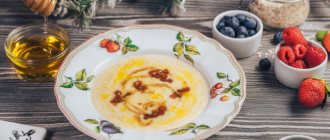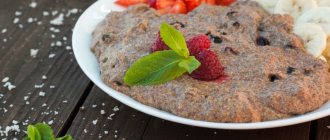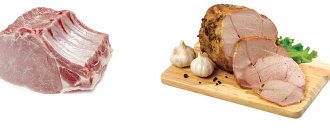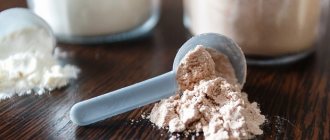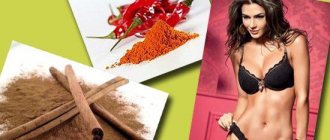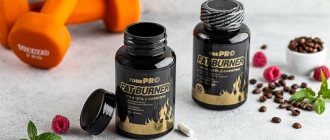Oatmeal: from antiquity to the present day
In Egyptian tombs that were built about four thousand years ago, archaeologists have found oat seeds. At the same time, oats themselves became the last of the cultivated cereals suitable for food.
From China and Mongolia to Asia and the north...
Scientists believe that the tribes who were engaged in farming in what is now Mongolia and China were the first to grow oats. At first it was mistaken for a weed and mercilessly mowed down to feed horses and cows. And then, quite by accident (as usually happens), they recognized it as a completely edible, and moreover, very tasty and healthy cereal.
It turned out to be easy to grow and required virtually no care, so oats spread throughout Asia and became almost as popular as rice. Then the cereal, in some cunning way, penetrated through Altai and the territories of the ancestors of the Slavs to the Scandinavians and inhabitants of the British Isles. Oats were boiled and ground into flour to make flat cakes. The Scots, for example, still have this as their favorite national dish.
…and then further across Europe
By the 1st century BC. e. the fame of oats also reached the arrogant Latins (by that time they were known as decent gourmets and sybarites). The ancient Romans learned that the fierce Vikings from the northern tribes cooked and ate a truly magical porridge that made them heroes, fearless and strong.
Oats appeared in North America thanks to the Scots
The freedom-loving Irish and Scots, descendants of the ancient Celts, brought with them to North America in the mid-18th century not only turnip lanterns, which were very soon replaced by pumpkins with a carved grin, but also oats. A hundred years later, oatmeal became a traditional breakfast dish in the New World.
Photo taken from Pinterest.
The Quaker Oats company, founded in 1877, was the first in the world to produce oatmeal in two-pound paper packages (that's almost a kilogram, which is convenient and familiar to us too). In the 1880s, American housewives quickly believed in the miraculous properties of oatmeal: any decent magazine featured advertisements with recipes and a detailed listing of the beneficial qualities of porridge with water or milk.
Oats in Russia: pre-Christian times
Historians claim that oats appeared among the Slavic tribes no later than the 7th century. They did without gastronomic delights: they pounded oats, cooked porridge and jelly from oatmeal, and baked flat cakes and pancakes. The cereal was highly valued in the harsh northern lands for its unpretentiousness. “Oats will even grow through bast shoes,” our ancestors said about them optimistically and lovingly.
Monk Nestor, the author of The Tale of Bygone Years, tells a glorious legend about Belgorod jelly (in a historical document it dates back to 997). Prince Vladimir Svyatoslavovich left the city to repel the warlike Pechenegs near Novgorod, but they insidiously took advantage of the absence of the governor and laid siege to the Belgorod fortress. The townspeople began to fear starvation, but found a clever way to get out of their hopeless situation. The invaders were allowed to taste the contents of two wells: a barrel of honey was buried in one, and a barrel of oatmeal jelly was buried in the other. The Pecheneg ambassadors believed that the Belgorod land was magically feeding the Slavs and went home with their troops.
Oatmeal: benefits and advantages
Why is oatmeal considered beneficial for everyone, including those who are forced to sit on a therapeutic or any restrictive diet?
Beta glucans
Oatmeal contains a lot of soluble dietary fiber - beta-glucans. The body needs them for this:
- allow you to feel full faster and feel full longer, as they are digested slowly;
- reduce the level of “bad” cholesterol in the blood;
- envelop the mucous membranes of the gastrointestinal tract, soothing them.
Cellulose
The most fiber is found in the shell of the grains: it helps normalize and reduce blood sugar levels, which makes oatmeal indispensable for people with sugar addiction, patients with both types of diabetes and those who suffer from vascular or heart diseases.
Insoluble fiber
It improves intestinal function, stimulating peristalsis, cleanses it, removing toxins.
Vitamins and microelements
Oatmeal is good for those who need a vitamin boost. It contains:
- tocopherol (vitamin E),
- niacin (vitamin B3),
- pyridoxine (vitamin B6),
- choline (vitamin B4: it is needed to protect the liver and remove harmful fats from it),
- silicon,
- iodine,
- potassium,
- cobalt,
- phosphorus and many other valuable microelements.
Proteins
They are needed at any age for muscle growth. In terms of protein content, only buckwheat is ahead of oatmeal. It is important that oatmeal is quite easily digested, so there is no feeling of overeating, a person can calmly play sports or actively move a short time after eating.
Katya's blog
A healthy breakfast is oatmeal! I think you guessed that the first place in terms of healthfulness of breakfast is, of course, oatmeal - the queen of all cereals. You can eat oatmeal with pleasure, the main thing is to learn how to cook it deliciously and add a variety of healthy ingredients, both to improve the taste and to nourish the body with a variety of vitamins. Oats contain a lot of fiber (about 4 grams in 1/2 cup of raw oatmeal) and about 6 grams of protein. Not only will oatmeal keep you feeling full longer than other breakfasts, but it is also very beneficial for the cardiovascular system. It is enough to eat one serving of oatmeal a day and your body will be filled with the necessary amount of fiber to reduce the absorption of cholesterol into the blood.
There are 3 types of oatmeal. And not every one of them is useful and nutritious for our body. - Porridge for a minute. Now in stores you can find a huge number of instant porridges, and not only oatmeal. Are these cereals healthy? Let's look at the composition of such porridges: oat flakes, sugar, pieces of dried berries, salt, dry cream substitute (whey powder, refined coconut oil), flavoring. I think definitely not. Firstly, they contain more sugar than you would put in for yourself. Secondly, dry cream substitutes, flavors and dyes have a negative effect on the body. Thirdly, the oatmeal itself is crushed and pre-processed, so that the porridge can simply be poured with boiling water and it will cook. Crushed and steamed flakes no longer contain fiber and vitamins. In my understanding, healthy eating is natural nutrition. And instant oatmeal is a chemical and does not bring any benefit. — Instant or extra oatmeal. This is, for example, oatmeal from the company Hercules. Of course, these porridges are prepared not as quickly as “minute” porridges, but much faster than traditional oatmeal. This type of cereal is healthier than cereal because it does not contain flavorings or dyes. However, these flakes are pre-steamed in order to reduce the time it takes housewives to prepare the porridge. And during pre-treatment, some vitamins and microelements disappear. — Traditional oat flakes. This is the healthiest breakfast, according to all experts and doctors. These flakes contain fiber, vitamins and microelements. You should not save time and buy instant porridge or instant porridge. After all, by saving time, you are worsening your health.
Oatmeal recipes: In order to prepare classic oatmeal, you will need 0.5 cups of oatmeal and 1 cup of water. This is the standard ratio of liquid to flakes. Everyone cooks according to their own discretion, some use more liquid, others use less. Salt is added to oatmeal to taste. Instead of water, you can use milk, then the oatmeal will be more nutritious. However, it is healthier to eat oatmeal with water, especially since it contains only 150 calories, and gives the body a feeling of fullness for a long time.
One serving of cooked oatmeal (approximately 1 cup of oatmeal) contains 150 calories, 3 grams of fat, 27 grams of carbohydrates, about 6 grams of protein, and 4 grams of fiber.
In order to enjoy eating oatmeal , you can add various tasty and healthy ingredients to suit your taste:
1. 2 tablespoons of dried (fresh or frozen) cranberries, 1 teaspoon of sugar, 1 tablespoon of chopped peanuts. (115 calories) 2. 2 tablespoons raisins, 1 tablespoon peanuts, 1 teaspoon sugar (125 calories) 3. 2 tablespoons cherries (frozen, dried, fresh), 1 tablespoon chopped almonds, 1 teaspoon sugar (115 calories) 4. 1/4 cup blueberries, 1 tablespoon chopped walnuts, cinnamon on the tip of a knife (70 calories) 5. 1/2 cup sliced apple, 2 tablespoons dried (fresh or frozen) cranberries (90 calories) 6. 1/ 2 cups chopped pear and 2 tablespoons dried (fresh or frozen) cherries (100 calories) 7. 1 tbsp. Nutella (hazelnut flavored chocolate spread), 1/2 banana (150 calories) 8. 1 cup sliced apples, 2 tablespoons raisins, sprinkle with cinnamon (140 calories) 9. 1/2 cup fresh or frozen blueberries, 1 tablespoon maple syrup, 1 tablespoon chopped walnuts (140 calories) 10. 1/2 cup chopped apples, 1 tablespoon raisins, 1 tablespoon peanut butter (165 calories) 11. 1 tablespoon honey, 2 tablespoons raisins, 1 tablespoon 1 tablespoon chopped walnuts (175 calories) 12. 1 tablespoon honey, 1 tablespoon peanut butter (160 calories) 13. 1/2 sliced banana, 1 tablespoon peanut butter (145 calories) 14. 1/2 cup chopped peaches, 1.5 tsp. sugar, 1 tablespoon slivered almonds (110 calories) 15. 1/3 cup unsweetened applesauce, cinnamon (35 calories) 16. 1/4 cup applesauce, cinnamon and allspice, 1 tablespoon dried (fresh or frozen) cranberries or cherries (170 calories) 17. 1/2 cup chopped fresh or frozen strawberries, 1 tablespoon slivered almonds (75 calories) 18. 3 tablespoons your favorite fruit (50 calories) 19. 1 tablespoon dry roasted peanuts, 1 tablespoon 1 tablespoon raisins (150 calories) 20. 1 tablespoon dry crushed banana chips, 1 tablespoon dry roasted peanuts, 1 tablespoon raisins (120 calories) 21. 1 tablespoon dried cranberries, 1 tablespoon raisins, 1 tablespoon finely chopped peanuts (130 calories) 22. Italian Oatmeal: 1/3 cup low-fat ricotta cheese, 1/2 cup chopped tomatoes (125 calories)
PS Don’t forget to subscribe to new articles and join Katya’s Blog group in contact https://vk.com/blogkaty
An anecdote for lovers of humor:) Sidorov, a concrete mixer operator, slipped and went headlong into his work.
Useful articles:
1. Healthy eating rules
2. The healing properties of honey - secrets for beauty and body
3. The most unhealthy potato dishes
Use of site materials is available only with an active link to the site: blogkaty.ru
Five little-known interesting facts about oatmeal
- Oatmeal is an excellent natural antidepressant. It's all about a decent content of B vitamins. Those who eat oatmeal regularly notice that stress levels decrease, insomnia goes away, and sleep itself becomes deep and restorative (vitamin B6 helps increase the synthesis of melatonin, the sleep hormone). By the way, isn’t the secret of the legendary British equanimity and stiffness hidden in the oatmeal?
- For the same reasons (a large amount of vitamins and proteins), oatmeal lovers can boast of smooth, healthy skin, beautiful shiny hair and good nails. Were you also told as a child that horses have such luxurious manes precisely because they eat oats?
- Oatmeal is good for removing heavy metal salts, toxins and waste from the body. As a result, digestion and blood circulation improve, internal organs and the brain begin to work more energetically.
- Oatmeal is an excellent cosmetic product. The flakes make effective natural masks for hair and skin. This mask is very good in spring: the skin quickly becomes clean, soft and soft, inflammation calms down, peeling goes away, and fine wrinkles are smoothed out.
- Oatmeal is also suitable for absorbing unpleasant odors - in the refrigerator, closet or trash can. It is enough to pour a small amount of flakes into a bowl - and after some time all extraneous aromas will be neutralized.
Still from the movie “The Hound of the Baskervilles,” 1981.
Secrets of buckwheat porridge
The easiest way to prepare buckwheat porridge. You need to bring 2 cups of salted water to a boil, add a glass of buckwheat into it and cook for 15-20 minutes over low heat with the lid closed. It is very important not to “torture” the porridge: after covering the pan with porridge with a lid, do not open it forty times and do not stir.
There are a great many recipes for making buckwheat porridge, one better than the other, but we would highlight one that we especially love for its simplicity and versatility. Porridge prepared according to this recipe can be used as a side dish, or as an independent dish.
- First, bacon cubes are fried in butter, then diced onions and mushrooms (white or champignons) are added.
- Everything is stewed for about five minutes, after which it is poured with salted water or broth, brought to a boil, then buckwheat is added.
- The porridge is cooked on the lowest heat. After 20–25 minutes the porridge is ready.
- Now all that’s left is to season it with oil, let it sit for another five minutes and mix well before serving.
7 products that make buckwheat porridge tastier, see here
Buckwheat porridge makes a delicious krupenik.
- For this, mix 4 faceted cups of crumbly buckwheat porridge, 2 cups of cottage cheese, grated through a sieve, 2 eggs, 50 g of softened butter, salt, sugar (to taste) in a large bowl.
- The mass is laid out in a round heat-resistant form, greased with oil and sprinkled with breadcrumbs, smeared with sour cream (1/2 cup) on top and baked in an oven preheated to 180 ° C until golden brown.
Buckwheat krupenik with cottage cheese, see recipe here
Harm of oatmeal
The best is the enemy of the good, so too much of even an extremely healthy product can harm the body. What happens if you eat only oatmeal?
For disorders of mineral metabolism, osteoporosis, anemia (and even for small children under 10 years old), an excessive amount of oatmeal will not be beneficial. Phytins, which are found in grains, legumes, nuts and oatmeal, bind cations of iron, magnesium, zinc and calcium - and the body absorbs them worse. In order to reduce the phytic acid content in the finished porridge, you can soak the flakes in plain water in the evening (don’t forget to drain it in the morning). It is also worth adding lemon juice or yogurt to your oatmeal.
Secrets of semolina porridge
Semolina porridge has its own secrets. For a glass of cereal we need 600 ml of milk. It seems that it could be simpler: bring the milk to a boil, pour in the cereal in a thin stream, stir, leave under the lid for 8-10 minutes - and you’re done. But it’s better to try one old proven method.
- First, semolina is simmered in a saucepan in butter until golden brown, then poured with milk (or a mixture of water and milk), flavored with sugar and a pinch of salt.
- Everything is quickly stirred and gurgles over low heat for about three minutes (with constant stirring).
- Then the semi-finished porridge is covered with a lid, which, in turn, is wrapped on top with a towel, and placed in an oven preheated to 180 °C for 10-15 minutes - until the semolina is completely swollen.
- When pouring the porridge into bowls, be sure to sprinkle it with cinnamon - just a little - or chocolate chips. Dream!
Read how to cook semolina porridge here
